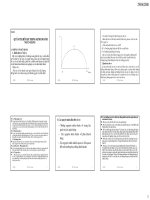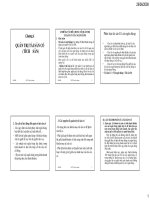slike bài giảng quản trị ngân hàng chương 3 managing and pricing deposit services
Bạn đang xem bản rút gọn của tài liệu. Xem và tải ngay bản đầy đủ của tài liệu tại đây (294.71 KB, 46 trang )
William Chittenden edited and updated the PowerPoint slides for this edition.
MANAGING AND PRICING
DEPOSIT SERVICES
Chapter 3
Key topics
•
1. Types of deposit accounts offered
•
2. The changing mix of deposits and deposit
costs
•
3. Pricing deposit services and deposit interest
rates
•
4. Conditional deposit pricing
•
5. Rules for deposit insurance coverage
•
6. Disclosure of deposit terms
•
7. Lifeline banking
12-2
Key issues depository institutions are faced
with
1. Where can funds be raised at lowest possible
cost?
2. How can management ensure that there are
enough deposits to support lending and other
services the public demands?
12-3
Types of deposit accounts
Transaction (payment or demand) deposits
Making payment on behalf of customers
One of the oldest services
Provider is required to honor any withdrawals
immediately
Non-transaction (savings or thrift) deposits
Longer-term
Higher interest rates than transaction deposits
Generally less costly to process and manage
12-4
Transaction accounts
Although the interest cost of transaction
accounts is very low, the non-interest costs can
be quite high
Generally, low balance checking accounts are
not profitable for banks due to the high cost of
processing checks
Transaction accounts
Most banks offer three different transaction
accounts
Demand deposits
DDAs (Demand Deposit Accounts)
Negotiable Order of Withdrawal
NOWs
Automatic Transfers from Savings
ATS
Types of transaction deposits
•
Noninterest-bearing demand deposits
Interest was prohibited by Glass-Steagall Act
One of the most volatile and unpredictable
sources of funds
Most deposits are held by business firms since
Regulation Q prohibits banks from paying explicit
interest on for-profit corporate checking accounts
12-7
Regulation Q: />Transaction accounts
Interest-bearing demand deposits with limited or no
check-writing privileges
Negotiable Orders of Withdrawal (NOW)- hybrid
savings instrument – pay interest
ATS (Automatic Transfers) Accounts
Customer has both a DDA and savings account
The bank transfers enough from savings to DDA
each day to force a zero balance in the DDA
account
For-profit corporations are prohibited from owning
NOW and ATS accounts
Transaction accounts
Money market deposit accounts
Short-maturity deposit (a few days, weeks, months)
Pay interest but holders are limited to 6 transactions
per month, of which only three can be checks
Attractive to banks because they are not required to
hold reserves against MMDAs
Held by both individuals and businesses
Non-transaction (savings or thrift) deposit
An account whose primary purpose is to
encourage the bank customer to save rather
than make payments.
12-10
Non-transaction accounts
Savings accounts: Have no fixed maturity
Denomination from $5
Withdrawal privileges are limited, but without prior notice
Stable fund to banks with little interest rate sensitivity
Low interest rate
For individuals, non-profit organization, businesses,
governments (firms cannot put > $150,000 in saving
deposits)
In form of
Passbook savings account
Statement savings account
Non-transaction accounts
Time deposits (CD is most popular type): Have a
specified maturity ranging from 7 days on up
Large time deposits (Jumbo CDs):
for corporation & wealthy individuals
in negotiable form CDs of $100,000-plus
Typically can be traded in the secondary market
many times before reaching maturity
Small time deposits (Jumbo CDs):
Usually acquired by individuals
nonnegotiable form CDs with smaller denomination
Cannot be traded before reaching maturity
Popular types of CDs
•
Bump-up CD – allows a depositor to switch to a
higher interest rate if market rates rise
•
Step-up CD – permits periodic upward
adjustments in the promised interest rate
•
Liquid CD – permits the depositor to withdraw
some or all of their funds without a withdrawal
penalty
12-13
Non-transaction accounts
Retirement savings deposits
Individual Retirement Account (IRA) - the
Economic Recovery Tax Act of1981
Keogh Deposit – have tax benefits
Roth IRA – The Tax Relief Act of 1997 allows
non-tax-deductible contributions
Default Option Retirement Plans – The Pension
Protection Act of 2006
12-14
Non-transaction accounts
Individual Retirement Accounts
Each year, a wage earner can make a tax-
deferred investment up to $3,000 of earned
income
Funds withdrawn before age 59 ½ are subject to
a 10% IRS penalty
This makes IRAs an attractive source of long-
term funding for banks
Interest rates on deposits depend on:
The maturity of the deposit
The size of the offering institution
The risk of the offering institution
Marketing philosophy and goals of the offering
institution
12-16
The changing composition of deposits in the US
12-17
* Saving deposits include MMDAs
Core deposits
A stable base of funds that is not highly
sensitive to movements in market interest rates
(low interest-rate elasticity) and which tend to
remain with the bank.
12-18
Core deposits
A large proportion includes transaction deposits and
low-yielding time & savings deposits.
Small time and savings deposits can be withdrawn
immediately, their effective maturity spans over years
Increase bank’s liability duration and reduce interest
rate vulnerability
Share in total deposits in small banks (80%) higher
than in large banks (63%) (FDIC: 2007)
Declining trend due to inflation, deregulation, stiff
competition and better educated-customers.
12-19
Holders of deposits
Private sector: individuals, partnership and
corporation (75%)
State and local government (4%)
Foreign governments, businesses, individuals,
mostly in off-shore offices
Other financial institutions (correspondent deposits)
Cost of deposits
Checkable deposits (checking accounts, special
checkbook deposits and interest-bearing checking
accounts)
Thrift deposits (money market accounts, time
deposits and savings accounts)
Business transaction accounts are more
profitable than personal checking accounts
Deposits are determined by public preferences
and competition
Cost and revenue accounting data for
deposit accounts at FirstBank
Check 21 and substitute checks
Effective October 28,2004 – permits depository
institutions to electronically transfer check images
The images are called substitute checks and is a
legal copy of the check
Protects depositors against loss
Benefits institutions by reducing the cost of check
clearing
Substitute checks can be sent electronically instead
of sending bundles of checks
More information:
12-23
Substitute check authorized by Check 21
FDIC insurance coverage
Banks insured through Bank Insurance Fund (BIF)
Savings and loans insured through Savings
Association Insurance Fund (SAIF)
Covers only those deposits payable in the U.S.
Many types of accounts are covered up to $100,000
(increased to $250,000 until year-end 2009 by the
Emergency Economic Stabilization Act of 2008) for
each account holder within the same bank (even if
different branches)
Deposits placed in separate institutions are insured
separately
12-25









